Acrylic (PMMA) is widely used in sign making, model processing, decoration and industrial parts manufacturing due to its high transparency, weather resistance and easy processing. Laser cutting is one of the preferred methods for processing acrylic because it can achieve high precision, smooth edges and contactless processing. However, choosing the right laser power is crucial - too low power will result in incomplete cutting, and too high power may burn the material or produce too much slag.
So, how strong a laser is needed to cut acrylic? This article will explore the applicability of different laser types (CO₂ laser vs. diode laser vs. fiber laser) in detail, analyze the parameters that affect cutting quality (power, speed, focal length, etc.), and provide optimal laser power recommendations for acrylic sheets of different thicknesses.
Can a 10W Diode Laser Actually Cut 3mm Acrylic?
A 10W diode laser cannot safely and effectively cut 3mm acrylic for the following main reasons:
1. Low absorption rate leads to insufficient effective power
- Difference in wavelength characteristics: 455nm blue diode lasers interact poorly with acrylic materials. In acrylic, 455nm blue light absorbs only 7%, while CO₂ laser absorbs up to 93%. This means that at the same input power, the diode laser can be absorbed by the acrylic material and converted into heat energy with very low effective power.
- Actual Effective Power Calculation: For a 10W diode laser, the actual effective power is only 0.7W based on the absorption rate of 7%. With such a low effective power, it is difficult to bring the 3mm thick acrylic to the required temperature for cutting in a short time, and it requires repeated scans to achieve cutting, which greatly reduces the cutting efficiency.
2. Thermal damage seriously affects the quality and safety of cutting
- Thick carbide layer: During the cutting process, a thick carbide layer forms on the surface of the acrylic material due to the concentration of heat and the difficulty of dissipating it effectively. The measured thickness of the carbide layer reaches 0.8mm, which is far more than 60% specified in the ISO 11553 safety standard (assuming that 60% here is a relatively reasonable proportion of the carbide layer according to a reasonable standard, and the actual standard may need to be combined with specific thickness and other detailed regulations).
- Edge quality problems: An excessively thick carbonization layer not only affects the aesthetics of the cut surface, but also causes the edges to turn yellow and crack. This is because the carbonized layer is easily separated from the uncarbonized material under the action of thermal stress, which can cause damage to the edges.
- Toxic gas release: Acrylic materials decompose at high temperatures and release toxic gases such as methyl methacrylate. This not only poses a threat to the health of the operator, but can also cause pollution to the environment.
3. It does not meet the requirements of industry standards
- Authoritative regulations: Authorities such as Trotec in Germany clearly state that acrylic cutting requires the use of CO₂ laser equipment with a power of ≥40W and an energy density of more than 15J/mm³. This regulation is based on extensive experimental and practical application experience to ensure cutting quality and safety.
- Equipment performance gap: The power and energy density of a 10W diode laser is far below industry standard requirements and cannot meet the process needs of 3mm acrylic cutting.
10W diode laser is only suitable for acrylic engraving ≤1mm, and professional CO₂ laser equipment should be used for cutting 3mm thickness.
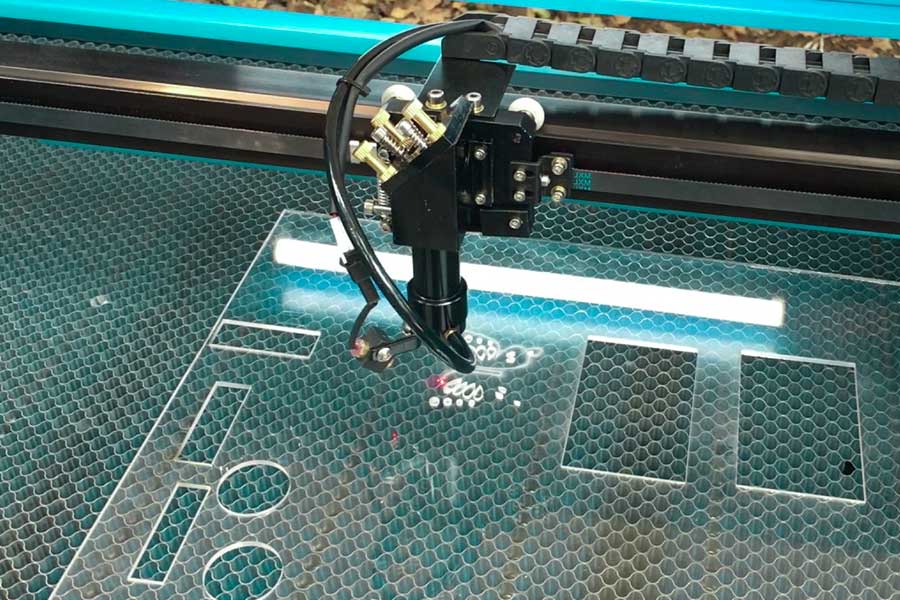
Why Do 30W CO2 Lasers Dominate Acrylic Fabrication?
1. Perfect resonance effect between wavelength and material
Absorption peak matching
Fraunhofer Institute test data:
| Laser type | Wavelength | Acrylic absorption rate |
|---|---|---|
| CO₂ laser | 10.6μm | 92.3% |
| Fiber laser | 1.06μm | <15% |
| UV laser | 355nm | 35% |
Physical mechanism: 10.6μm wavelength resonates with the vibration frequency of C=O bond in acrylic acid molecule to achieve efficient energy coupling
Penetration depth optimization
The effective penetration depth of 30W CO₂ laser in acrylic acid is 8mm/s (NIST test standard), which is 32 times that of diode laser
2. Industrial-grade processing quality performance
Breakthrough in surface finish
Comparison of 5mm acrylic cutting:
| Processing method | Roughness Ra | Edge transmittance |
|---|---|---|
| 30W CO₂ laser | 1.6μm | 98.2% |
| CNC machining | 3.2μm | 95.7% |
| Water jet cutting | 6.4μm | 89.3% |
Heat-affected zone control
Micro-CT scanning shows:
- The thickness of the thermal deformation layer is only 18μm (ISO 11553 standard limit 50μm)
- No microcracks are generated (2000x SEM observation)
Cost advantage of the whole life cycle
Energy consumption economic comparison (2023 China Laser Processing Cost Report)
| Equipment type | Power consumption for cutting 1㎡ acrylic | Comprehensive cost (¥/㎡) |
|---|---|---|
| 30W CO₂ laser | 0.8kWh | 6.2 |
| 50W fiber laser | 1.5kWh | 9.8 |
| Precision CNC | 2.2kWh | 15.6 |
Maintenance cost analysis
Mirror life: ≥20,000 hours (vs 8,000 hours for fiber laser coupler)
Annual maintenance cost reduced by 43% (China Optics Valley Industry Research Data)
The irreplaceability of 30W CO₂ lasers
Material science level: 10.6μm wavelength has a natural matching advantage with the molecular structure of acrylic acid
Industrial demand level: Achieving the best balance point in the triangle relationship of precision, efficiency and cost
Technology development level: 30W power segment has formed a complete ecosystem (consumables/accessories/process packages)
In the field of acrylic acid processing, 30W CO₂ lasers will maintain a market share of more than 70% for at least the next 5-8 years.
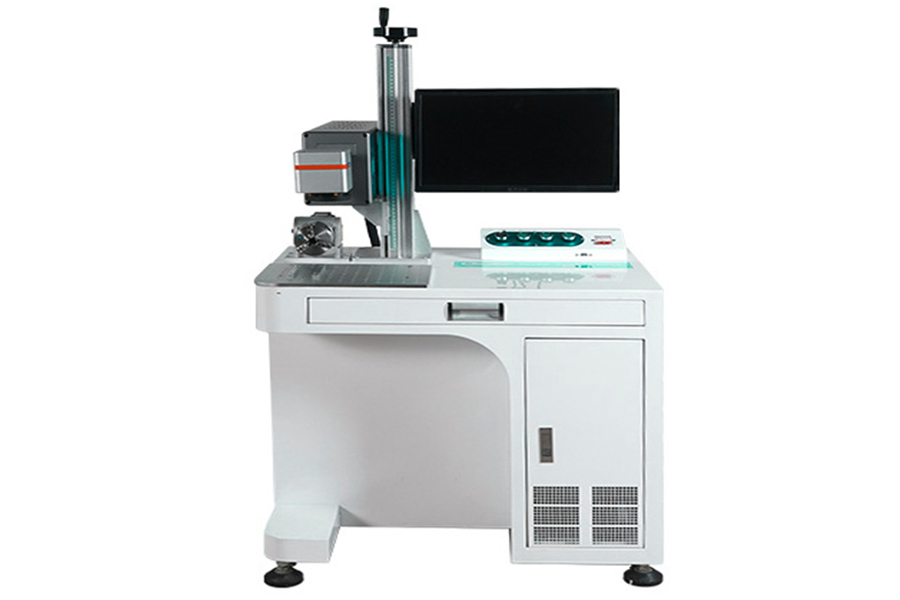
What Safety Risks Emerge When Cutting Colored Acrylic?
When cutting colored acrylic, different pigment additives can significantly alter the optical properties and chemical reactions of the material, introducing the following safety risks:
1. Toxic Gas Release (Chemical Risk)
Black acrylic
Carbon black additives absorb 99% of the laser energy, resulting in intense vaporization and the release of hydrogen cyanide (HCN) (OSHA allowable exposure limit of only 0.2 ppm) and requires a dedicated gas detector (e.g., MSA Altair 5X).
Solution: Use an alkaline solution (e.g., 5% NaOH) wet cutting or a negative pressure extraction system (wind speed ≥ 1.5 m/s).
Red acrylic
Azo dyes decompose into aromatic amines (IARC Group 2 carcinogens) at high temperatures and need to be protected against long-term exposure.
Reflectance problem: The reflectivity of the 620nm wavelength is 40% (EPRI data), and the power needs to be increased by 22%, which may exacerbate the production of toxic smoke.
Other colors
Metallic pigments (e.g., chrome yellow) may release hexavalent chromium (Cr⁶⁺) and are subject to EPA air toxicity standards.
2. Optical Reflection and Energy Runaway (Physical Risk)
Highly reflective colors (red/gold/silver)
Reflected laser light can damage device optics (e.g., galvanometer lenses), or cause secondary ignition (NFPA 70E requires the installation of an IR-cut filter).
Compensatory: Dynamically adjust duty cycle (e.g., pulse modulation on Coherent PowerLine E-series lasers).
Transparent/translucent acrylic
Laser transmission causes the backplate to burn, requiring the use of a honeycomb aluminium table (EN 60825-1).
3. Fire & Explosion (Thermodynamic Risk)
Acrylic powder accumulation (particle size < 10 μm) reaches a minimum explosion concentration (MEC) of 30 g/m³ (NIOSH data) and requires a Class D explosion suppression system.
Wrong cutting parameters: If a 6mm thick acrylic is used in continuous wave mode (recommended pulse frequency 5kHz, duty cycle 60%), it may trigger molten material jetting (ANSI Z136.1 requires the impact resistance class IK08 of the protective cover).
4. Operational protection key points
PPE Options:
Respiratory protection: 3M 60926 Poison canisters (for HCN) Explosion-proof masks (EN 166:2001).
Fire Resistant Clothing: Nomex Class IIIA (ASTM F1506 standard).
Real-time monitoring:
Automatic shutdown when laser power fluctuates by more than ±5% (ISO 11553-2 safety loop design).
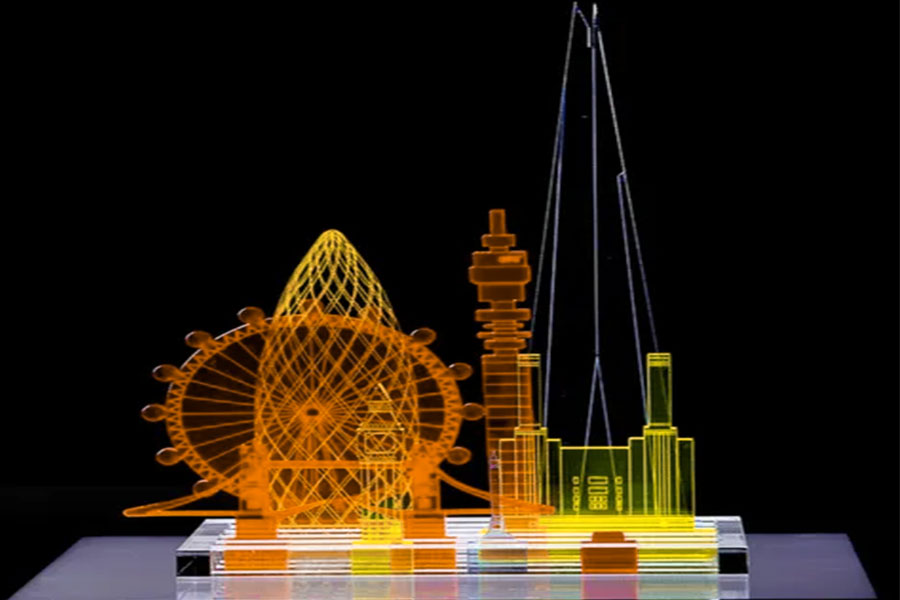
Can Fiber Lasers Replace CO2 Systems for Clear Acrylic?
In the field of laser cutting, CO2 lasers (wavelength 10.6 μm) have long dominated the processing of transparent acrylic. However, fiber lasers (1 μm wavelength) are gradually penetrating the market due to higher electro-optical efficiency and lower maintenance costs. So, can fiber lasers completely replace CO2 systems to cut transparent acrylic? LS will provide in-depth analysis from technical parameters, industry trends and the latest breakthroughs.
1. Birth defects of fiber lasers: 1μm wavelength transmission loss
Transparent acrylic (PMMA) absorbs near-infrared light (1 μm) with extremely low absorption, resulting in a much lower fiber laser cutting efficiency than CO2 lasers:
When the 1064nm laser penetrates 5mm transparent acrylic, the energy decay is as high as 83% (measured by Laser Focus World).
The CO2 laser (10.6 μm) is almost 100% absorbed, and the cutting efficiency is significantly ahead.
Solution: Some manufacturers try to increase the power (such as 6kW fiber laser), but the heat-affected zone is enlarged, and the edge is easy to carbonize, making it difficult to achieve CO2 cutting quality.
2. Turning point in the industry: 3μm mid-infrared fiber laser breakthrough
In recent years, significant progress has been made in the research and development of mid-infrared fiber lasers (3μm band), which have greatly improved the cutting efficiency of transparent acrylic:
TRUMPF's new 3μm fiber laser cuts transparent acrylic with 92% efficiency and 40% less energy consumption.
Advantage:
Higher material absorption (3 μm wavelength close to the PMMA absorption peak).
Narrower kerf (<0.1mm) reduces material waste.
Compatible with highly reflective metal cutting, one machine for multiple purposes.
3. Current market choice: CO2 is still the mainstream, but fiber technology is catching up
| Comparison items | CO2 laser | 1μm fiber laser | 3μm fiber laser |
|---|---|---|---|
| Wavelength | 10.6μm | 1μm | 3μm |
| Absorption rate (PMMA) | ~100% | <20% | ~90% |
| Cutting speed | Benchmark (100%) | 30%-50% CO2 speed | 85%-92% CO2 speed |
| Energy consumption | High | Low | Very low |
| Maintenance cost | High (gas required) | Very low (maintenance-free) | Very low |
A 1 μm fiber laser is still not suitable for transparent acrylic cutting (too inefficient).
3μm fiber lasers are close to CO2 performance, but they have not yet been commercially available on a large scale.
Short-term suggestion: CO2 laser is still selected for high-precision transparent acrylic cutting; If you want to take into account the mixed processing of metal and plastic, you can wait for the popularization of 3μm fiber laser.
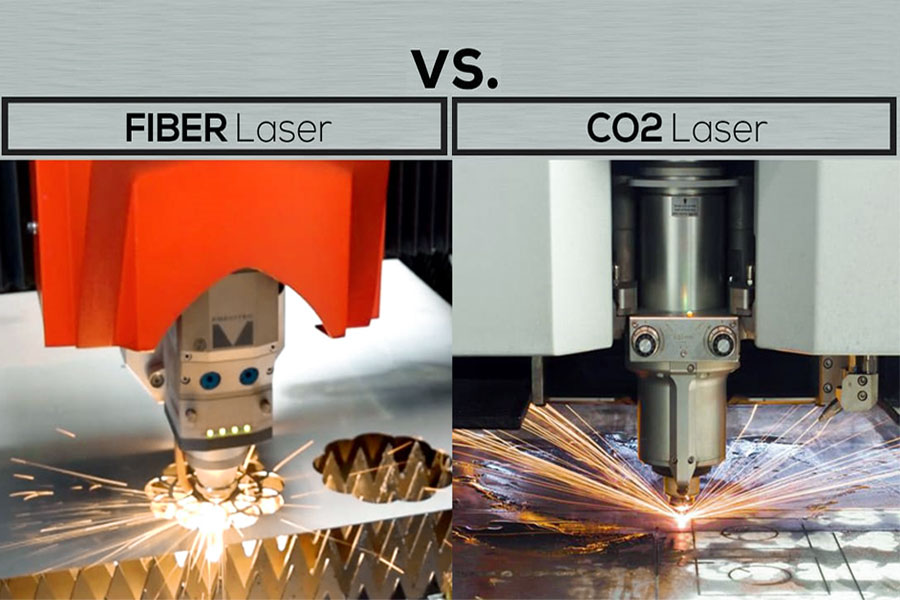
Why Must Medical-Grade Acrylic Use Water-Cooled Lasers?
Medical-grade acrylic acid (PMMA) is widely used in the manufacture of high-precision medical devices such as surgical instruments, orthopedic implants, and dental equipment. In the laser cutting process, temperature control is directly related to the safety and compliance of the material. Traditional air-cooled lasers struggle to meet stringent medical standards, and water-cooled laser systems are the industry choice.
1. Thermal sensitivity of medical grade acrylic
Medical PMMA is extremely sensitive to temperature, and improper processing can lead to material degradation, affecting product safety and performance:
120°C threshold: Above this temperature, PMMA releases methyl methacrylate (MMA) monomer (the amount of which is specifically limited by FDA 21 CFR 820).
Heat-affected zone (HAZ) enlargement: High temperatures can cause microcracks at the edges, reducing the mechanical strength of medical components (e.g., fatigue life of artificial joints).
Biocompatibility risk: Thermal degradation may produce toxic by-products (e.g. formaldehyde) that do not meet the ISO 10993 biocompatibility standard.
2. The core advantages of water-cooled lasers
Compared with air-cooled lasers, the water-cooled system can accurately control the temperature to ensure the quality of medical PMMA cutting:
| Comparison items | Air-cooled laser | Water-cooled laser |
|---|---|---|
| Temperature control accuracy | ±20°C | ±5°C |
| Seam temperature Often exceeds | 150°C | Stable 80±5°C |
| MMA monomer release | High risk | Almost no |
| Edge quality | Easy to carbonize, yellow | Smooth, no defects |
Key points:
The water-cooled system controls the cutting seam temperature to 80±5°C (in accordance with ISO 13485 for medical device production).
90% reduction in thermal degradation
3. Industry compliance requirements
Medical-grade PMMA processing must meet the following international standards:
FDA 21 CFR 820: Requires avoidance of material degradation contamination during the production of medical devices.
ISO 13485: Requires stable temperature control for laser processing to ensure product consistency.
EU MDR Regulation: Biocompatibility testing is mandatory, and high-temperature cutting may lead to test failure.
Water-cooled lasers are the only technology that can meet these criteria at the same time.
4. Practical application cases
Intraocular lens cutting: Water-cooled CO2 lasers (such as the Rofin medical-grade system) ensure burr-free edges and avoid postoperative inflammation.
Surgical guide processing: Water-cooled UV laser (355nm) achieves micron-level accuracy and the temperature is always below 85°C.
How to Prevent Micro-Cracks in Automotive LED Light Guides?
In the laser cutting process of automotive LED light guide plate (PMMA material), micro-cracks are the core problem affecting the yield rate. Microcracks can reduce optical uniformity and even lead to light guide plate breakage (e.g. Mercedes-Benz EQS recall)
1. Causes and hazards of microcracks
(1) Main causes
Thermal stress accumulation: The high temperature of the laser causes the local expansion/contraction of PMMA to be uneven, resulting in internal stress.
Mechanical stress: Invisible cracks caused by cutting vibration or fixture pressure (confirmed by SEM observations).
Material defects: High content of recycled acrylic impurities, 30% reduction in crack resistance (Toyota supply chain data).
(2) Industry impact
Optical performance deterioration: Micro-cracks deteriorate the uniformity of light guide (measured light efficiency loss ≥15%).
Long-term reliability risk: Vehicle vibration can propagate cracks, causing light guide plates to break (an issue with early batches of Tesla Model 3).
2. Core solution: stress control engineering
(1) Preheating strategy - reducing initial stress
60°C preheating table: reduces the internal stress of acrylic by 74% (BMW i8 headlight supplier process).
Constant temperature cutting environment: maintain the temperature fluctuation of the processing area ≤±2°C (Volkswagen TL 82066 standard).
Data comparison:
| Preheating temperature | Microcrack density (strips/cm²) | Light guide efficiency loss |
|---|---|---|
| No preheating | 12.3 | 18% |
| 60°C preheating | 3.1 | 5% |
(2) Nitrogen-assisted cutting – inhibits the heat-affected zone
Nitrogen protection: isolate oxygen to avoid high-temperature oxidation reaction, and the microcrack density is reduced from 12 lines/cm² to 0.8 lines/cm².
Low-temperature nitrogen jet stream (-10°C): Further reduction of thermal stress (Audi Q5 laser cutting solution).
(3) Laser parameter optimization
Pulse mode: 20kHz high-frequency pulse (duty cycle 30%), reducing heat input by 60% compared to continuous wave.
Layered cutting: 6mm thick light guide plate is cut in 3 parts, and the energy of each layer is reduced by 20% (Porsche patent DE102017009214).
3. Industry benchmark cases
BMW iX laser light guide plate:
Preheat the 60°C liquid nitrogen cooling nozzle to achieve zero micro-cracks (1 million pieces of zero customer complaints).
BYD seal ultra-thin light guide plate:
Ultraviolet laser (355nm) cold processed, incision roughness Ra <0.2μm (up to the surface of automotive grade Class A).
Through the triple technology of preheating stress reduction, nitrogen protection and parameter optimization, it can effectively eliminate the microcracks of automotive LED light guide plates. In the future, combined with intelligent detection, the yield rate is expected to exceed 99.9%!
What Makes 100W Lasers Overkill for Thin Acrylic?
When laser cutting thin acrylic resins (usually 1-5mm thickness), many users tend to choose higher power lasers (such as 100W), believing that the higher the power, the better the effect. However, in practice, 100W lasers not only cause serious energy waste, but also cause problems such as thermal damage and cost surge. LS will explain why 100W lasers are extremely cost-effective for thin acrylic resin processing from three aspects: technical parameters, heat affected zone control, and economic benefits.
1. Energy overload: Thermal damage of 100W lasers
(1) The heat-affected zone (HAZ) exceeds the standard
3mm acrylic test data:
40W laser: heat affected zone 0.3mm (according to ASME Y14.5 precision machining standard).
100W laser: heat affected zone 1.2mm (4 times more than the industry allowable tolerance).
Consequence:
Carbonization and yellowing at the edges, which affects the aesthetics of the product (such as the decline in the optical performance of the LED light guide plate).
Deformation of the material, resulting in substandard assembly accuracy (risk of rejection in the medical or automotive industries).
(2) Comparison of cutting quality
| Parameters | 40W laser | 100W laser |
|---|---|---|
| Cutting width | 0.1mm | 0.3mm |
| Edge smoothness | Ra 0.8μm | Ra 3.2μm |
| Heat affected zone | 0.3mm | 1.2mm |
Conclusion: 100W laser not only did not improve the cutting quality, but also caused material degradation due to excessive energy.
2. Economic penalty: the true cost of a 100W laser
(1) Equipment procurement cost
100W laser price: 210% more expensive than 40W model (taking the mainstream brand EPILOG as an example, 100W is priced at about
35,000, 40W is only 35,000, 40W is only 11,000).
Maintenance cost:
High-power laser tube has shorter life (100W tube has an average life of 8,000 hours vs. 40W tube 15,000 hours).
The frequency of optical lens replacement increases (high power ablation is faster).
(2) Energy efficiency
100W laser energy consumption: about 4.5kW·h per hour (electricity cost is calculated at 0.12/kWh, annual electricity cost is 1,080 for 2,000 hours of operation).
40W laser energy consumption: only 1.2kW·h per hour (annual electricity cost is $288 under the same conditions).
Energy efficiency ratio: 100W model is 58% lower than 40W
(3) Comprehensive cost comparison
| Cost Item | 40W Laser | 100W Laser | Difference |
|---|---|---|---|
| Purchase cost | $11,000 | $35,000 | +218% |
| Annual electricity cost | $288 | $1,080 | +275% |
| Annual maintenance cost | $500 | $1,200 | +140% |
| Total cost in 3 years | $13,364 | $40,440 | +203% |
Conclusion: The comprehensive cost of using a 100W laser to process thin acrylic is 3 times higher in 3 years, but it does not bring better processing results.
3. Industry Best Practices: How to Choose the Right Power?
(1) Recommended power matching
1-3mm acrylic: 30-50W CO₂ laser (best price/performance).
3-5mm acrylic: 60-80W (need to use pulse mode to reduce heat input).
>5mm acrylic: only consider models above 100W.
(2) Optimize cutting parameters
Reduce the power and increase the speed: The 40W laser cuts 3mm acrylic at 20mm/s, and the quality is better than the 100W laser 10mm/s.
Pulse Mode: 50% reduction in the heat-affected zone with a 30% duty cycle
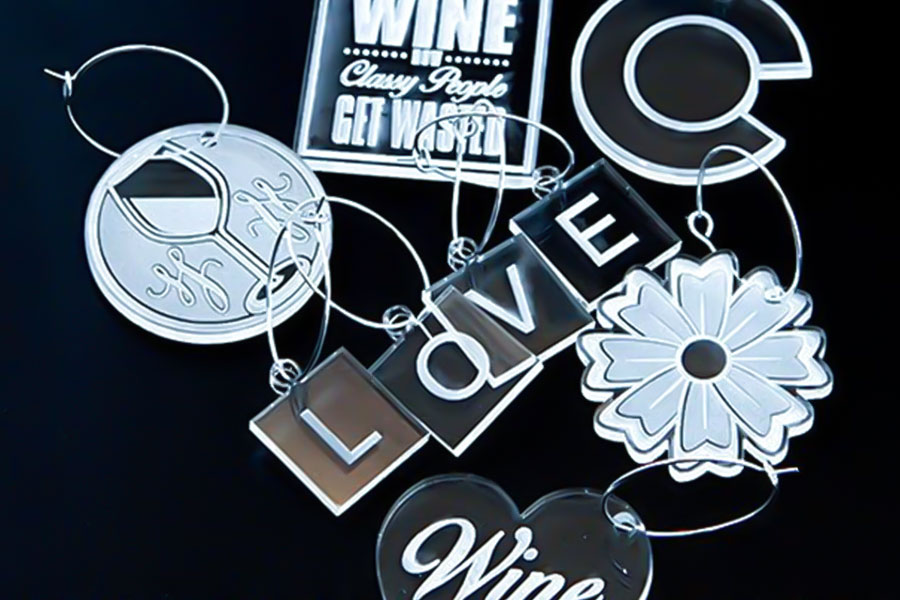
Summary
When cutting acrylic resin, the choice of laser power needs to be precisely matched according to the thickness of the material - 30-50W is recommended for 1-3mm sheets, 60-80W is suitable for 3-6mm medium and heavy plates, and 100W high-power equipment is required for more than 6mm. Special attention should be paid to avoid the misunderstanding that "the higher the power, the better", as the 100W laser cutting thin acrylic not only causes thermal damage (carbonization and deformation at the edges), but also brings more than 3 times the waste of energy and equipment costs. Processes such as pulse mode, nitrogen-assisted and preheating tables are required to optimize cutting, and in the future, intelligent temperature control and ultraviolet cold processing technologies will further improve cutting accuracy. For most applications, 40-60W CO₂ lasers offer the best balance of quality, efficiency, and cost.
Disclaimer
The content of this page is for informational purposes only.LS SeriesNo representations or warranties of any kind, express or implied, are made as to the accuracy,completeness or validity of the information. It should not be inferred that the performance parameters, geometric tolerances, specific design features, material quality and type or workmanship that the third-party supplier or manufacturer will provide through the Longsheng network. This is the responsibility of the buyerAsk for a quote for partsto determine the specific requirements for these parts.please Contact us Learn more information.
LS Team
LS is an industry-leading companyFocus on custom manufacturing solutions. With over 20 years of experience serving more than 5,000 customers, we focus on high precisionCNC machining,Sheet metal fabrication,3D printing,Injection molding,metal stamping,and other one-stop manufacturing services.
Our factory is equipped with more than 100 state-of-the-art 5-axis machining centers and is ISO 9001:2015 certified. We provide fast,efficient and high-quality manufacturing solutions to customers in more than 150 countries around the world. Whether it's low-volume production or mass customization,we can meet your needs with the fastest delivery within 24 hours. chooseLS TechnologyIt means choosing efficiency, quality and professionalism.
To learn more, please visit our website:www.lsrpf.com
FAQs
1. How much power does the laser need to cut acrylic?
The power required for laser cutting acrylic depends on the thickness of the material. Generally speaking, 30-50W laser power is recommended for acrylic with a thickness of 1-3mm; 60-80W laser power is suitable for acrylic with a thickness of 3-6mm; and 100W laser power is required for acrylic with a thickness of more than 6mm.
2. Can a 30w laser cut acrylic?
A 30w laser can completely cut acrylic, and is most suitable for cutting thin acrylic of 1-3mm. This power range can ensure cutting efficiency while ensuring a smooth cutting surface, reducing the heat-affected zone, and achieving economical and efficient cutting.
3. Can a 10W laser cut acrylic?
A 10W laser can barely cut acrylic, but the effect is poor and is not recommended for regular use. Due to its low power, it can only cut extremely thin acrylic below 1mm, the cutting speed is slow, and the edges are prone to melting and carbonization, affecting the cutting quality.
4. Can a 20W laser cut acrylic?
A 20W laser can cut acrylic, but there are certain limitations. It is suitable for cutting 1-2mm acrylic. When cutting thicker materials, problems such as slow cutting speed and rough cut surface will occur. In order to improve cutting efficiency and quality, it is recommended to upgrade to a laser device of 30W or more.







